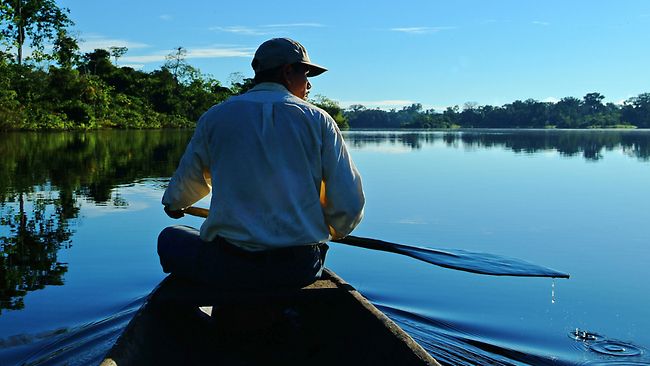As freshwater disappears from the super-populated Peruvian coast, the most water-intensive crops are expanding unabated as highly profitable exports. Observers warn about the harm this is causing and demand greater responsibility from the government and all involved.
With rising international commodity prices, the value of Peruvian exports reached more than 3 billion dollars between January and November 2010 — 30.2 percent more than the same period in 2009.
One example of this boom is the asparagus industry, which employs 120,000 people in the fields alone, according to official figures. But this crop requires huge volumes of water.
One hectare of asparagus needs 22,000 cubic metres of water. That is seven times more water than is needed to grow the displaced ‘quebranta’ grape, the traditional crop of the southwestern department of Ica, according to David Bayer, of IPROGA, a non-governmental institute promoting water management.
Bayer told Tierramérica that the water-use estimate is ‘far below the real figure, because it doesn’t include the water used in packaging the product for export or for preparing and applying agro-chemicals.’
He argued that another 2,000 cubic metres per hectare of asparagus should be added. Experts say it is a heavy ‘water footprint’ and needs to be taken seriously.
Ica and La Libertad, a department in northwest Peru, are the coastal regions with the most land dedicated to asparagus, although they are the most arid in the country.
Along the Pacific coast lives 70 percent of the Peruvian population, with an average of 2,000 cubic metres of water available per person per year. In the Peruvian Amazon, meanwhile, lives just 26 percent, with 291,000 cubic metres of water available.
‘The water footprint is an issue that requires action by everyone: the companies, the government, and the Peruvians in general, and we must all work towards the sustainability of this scarce resource,’ Laureano del Castillo, a researcher with the Peruvian Social Studies Centre, told Tierramérica.
An expert in water and rural policy issues said it is important ‘to show how water is used in the different production processes of the industry, because it is not viable to continue growing water-intensive crops in desert zones.’
However, Roxana Orrego, an expert in bioenergy and climate change at the Ministry of Agriculture, told Tierramérica that while the water footprint is linked to her country’s food sovereignty, the issue ‘is not being taken into consideration’ in her area.
‘It is a criteria of the United Nations but is not something effectively implemented in the countries,’ she said.
The Ica aquifer is one of the largest underground water reserves along the Peruvian coast, but is being depleted, and if the current pace continues, it could disappear by 2013, warned Bayer.
The people of Ica have less than 2,000 cubic metres of water available per person per year, which is already considered a ‘water stress’ situation.
According to a report from the Geological Mining and Metallurgy Institute from 2006-2007, water shortages in Ica have reached ‘critical levels.’
Overexploitation of water resources has combined with climate change and the subsequent melting of glaciers in Huancavelica, the region neighbouring Ica, and which supplies water to its rivers.
And the rainy season came late this year. Instead of beginning in October, the rains came in January, according to Peru’s National Weather and Hydrology Service. But even with the January rains, the Ica River was flowing 77 percent below normal.
‘We must reinforce the environmental focus of agro-industry,’ said Alberto Limo, an official with the Ministry of Environment who participated with other experts in a related conference organised by the Pontifical Catholic University of Peru.
The experts pointed to another challenge: biofuel production, which is also being promoted along the coast, using sugarcane to produce fuel. This is another crop that requires great quantities of water. However, it is being promoted as a way to combat climate change.
What are the answers? Bayer proposes that the six largest farm export companies in Ica should cut their cultivated areas in half ‘to save about 75 million cubic metres of water annually.’
The total surface water utilised by the 14,006 irrigation sites in Ica is 633 million cubic metres per year, with 563 million cubic metres from underground sources, mostly by agro-exporters, while overexploitation of the aquifer reaches 311 million cubic metres, said Bayer.
But José Chlimper, president of Agrokasa, Ica’s leading asparagus producer, said the water scarcity is ‘relative.’ In a column published in the local Correo newspaper, he wrote that there is a disinformation campaign ‘promoted by hidden interests.’
‘Both the Río Seco Irrigation Council and that of Ica and Villacurí are working on responsible water use programmes and on formulating a strategic public-private plan to reinforce the aquifer’s sustainability,’ said Chlimper, who insisted that the key is efficient water use. The companies in the area prefer to use the drip system, in which less water is lost to evaporation.
But Bayer countered, ‘Those companies have never paid for the underground water that they pump in their wells.’
‘The new Law on Water Resources (March 2009) now requires a fee for use. Meanwhile, the small farmers who irrigate with surface waters have always paid,’ he said.
Environmental official Limo, meanwhile, said that the administration of President Alan García is working on an ecological watershed project to determine the capacity of each one.
But water resource expert Del Castillo told Tierramérica that such a study should be conducted with the watershed councils, whose participation is required by law — but the councils have yet to be created.
*This story was originally published by Latin American newspapers that are part of the Tierramérica network. Tierramérica is a specialised news service produced by IPS with the backing of the United Nations Development Programme, United Nations Environment Programme and the World Bank.
by Milagros Salazar
Источник: © Inter Press Service (2011) — All Rights Reserved


